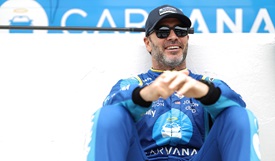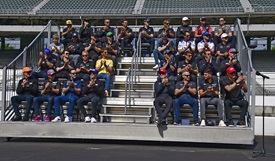Green Flag: 106th Indianapolis 500 presented by Gainbridge
MAY 29, 2022
A year of waiting is finally over. It’s time for the 106th Running of the Indianapolis 500 presented by Gainbridge.
It’s been a grueling two -week stretch of practice, qualifying and race prep for the stars of the NTT INDYCAR SERIES as they all look to etch their names in history as a winner of “The Greatest Spectacle in Racing.”
Firestone is supplying nearly 5,000 tires for the Indianapolis 500. Each entry has received an allocation of 34 sets of Firestone Firehawk tires to use during practice, qualifying and the race. These race tires are specially designed and are used nowhere else in the world. This year’s allocation are the exact same tires used in last year’s race.
Conditions are expected to be near perfect in Speedway, Indiana, for today’s racing on the historic 2.5-mile Indianapolis Motor Speedway oval. Temperatures are expected to be around 75 degrees at the time of the green flag, with a high of 84 expected for the partly cloudy day.
You can catch the action live on NBC, Telemundo Deportes on Universo and INDYCAR Radio Network beginning at 11 a.m. (ET). You can listen to the radio broadcast live on network affiliates, SiriusXM 85 and 160, INDYCAR.com and INDYCAR Mobile App powered by NTT DATA.
Here’s what you need to know to get ready for today’s action:
Rebounding from Wreck
Two drivers are starting today’s Indy 500 after crashes just two days ago: David Malukas and Colton Herta.
Both were involved in separate Turn 1 accidents during final Indy 500 practice Friday on Miller Lite Carb Day. At 1:44 p.m., Malukas attempted to pass Santino Ferrucci in his No. 18 HMD Honda.
Malukas and Ferrucci touched wheels, and Malukas’ right rear tire went down, sending him into a late spin at the exit of Turn 1 and into the SAFER Barrier. Malukas’ Dale Coyne Racing with HMD team was able to repair the car, and he will not be in a backup car.
Meanwhile, Herta had a massive accident in Turn 1 just a few minutes after Malukas’ accident. Herta wiggled in the No. 26 Gainbridge Honda and made right rear contact with the SAFER Barrier at the exit of the turn. The car overturned and slid through the short chute between Turns 1 and 2, making secondary contact with the SAFER Barrier in Turn 2 with the nose of the car.
Herta was re-evaluated Saturday after his accident and was cleared to return to racing. His Andretti Autosport Honda, on the other hand, was not good to go. Herta will have to start today’s Indy 500 in a backup car.
Start Up Front, Stay Up Front
Yes, today’s race is a 500-mile affair. And yes, there are plenty of passing opportunities on the track and on pit road. But often, the race winner is starting up front.
Seventy-five percent of Indianapolis 500-Mile Races have been won from the front third of the field. Last year’s winner, Helio Castroneves, started eighth en route to his historic fourth Indy 500 victory.
Over the last decade, only Ryan Hunter-Reay has won “The Greatest Spectacle in Racing” after starting in the second half of the field. He started 19th en route to Victory Lane in 2014.
The most successful starting position in Indianapolis 500 history is first, with 21 drivers having won the race from the pole. The last to do so was Simon Pagenaud in 2019. Scott Dixon, who won the NTT P1 Award for pole with the fastest four-lap average pole speed in history, must feel good about his chances. He’s had fast cars in each of the last two “500’s.”
The second most successful starting spot is third, with 13 drivers finding Victory Lane after starting third. The last driver to win from third was Takuma Sato in 2020. Rinus VeeKay starts third today.
No. 2 is the third-best starting position in history with 11 drivers using the middle of the front row to catapult into the racing history books. But it’s been a while since second has produced a winner – 21 years, in fact. The last Indy 500 winner to start second was Juan Pablo Montoya when he won his first Indy 500 in 2000. Reigning NTT INDYCAR SERIES champion Alex Palou starts second today.
The lowest starting position to produce a winner is 28th. Two drivers have risen from that far in the field – Ray Harroun in 1911 and Louis Meyer in 1936. Rookie Kyle Kirkwood starts 28th this year.
This Is Strategic Race
With passing potentially being at a premium during this year’s race due to the ultra-competitive field, expect pit strategy to play a factor all day long, as it often does.
You could see it up front as drivers jockey for who isn’t leading the race – that’s how last year’s race started as Colton Herta and Rinus VeeKay were eager to be in first while polesitter Scott Dixon opted for the second- or third-place running position to save fuel.
When teams and drivers in the back half of the field see an opportunity to deploy an opposite strategy to the leaders, they’ll likely take advantage of that. Most often, these opportunities come when a caution falls at a time that doesn’t fit an already planned fuel cycle.
Inevitably, this will produce multiple drivers leading late in the race, hoping that a caution will come out and end the race under yellow flag conditions. That’s how Takuma Sato secured his second Indy 500 victory in 2020.
Sato is often a driver that plays the alternate strategy, as is Felix Rosenqvist, Santino Ferrucci and Sage Karam – all four of these drivers have led late in the last two Indy 500’s looking to get some luck and drink the milk on Victory Podium.



















